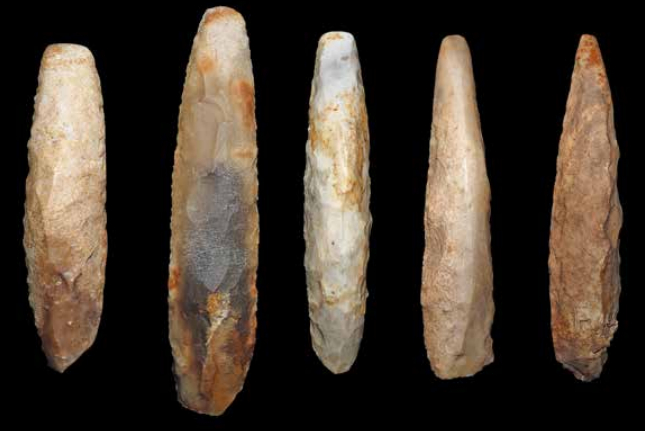|
Five Chisel Cache
|
by Bruce Francis |
| Central States Archaeological Societies 2025 October Journal |
Carbondale, Illinois |
| |
|
|
This excerpt from "Five Chisel Cache" published
in the 2025 Central States Archaeological Societies 2025
October Journal
Read the complete column in the Central States
Archaeological Societies 2025
October Journal which can be purchased on-line after March 2026 |
 |
Figure 1.The top face of the cache of five chisels.
|
On April 4th, 2012, my long-time friend, Jim, and his companion were hiking
along the base of a small bluff line on private property in Jackson County,
Illinois, when they noticed a small cavity in the rock at ground level. Jim
described it as a space “…about big enough to push a wheelbarrow
into." His companion crawled into the hole and began to scratch around,
soon uncovering two flint chisels approximately six inches in length. The
chisels were standing upright, just a couple of inches beneath the soil surface.
They did not explore the space further, but hiked back to the house where
his companion gifted Jim the chisels. Later that day, Jim called his brother
and his father – his father being a relatively well-known avocational
archaeologist and invited them to come and help fully explore the little
cave.
A few days later, they returned and excavated the floor of the small cave,
finding three more chisels. These three were in the same spot as the previous
two, but had settled horizontally in the soil rather than remaining upright.
The arrangement of the five artifacts suggested that all had likely been
buried together, standing upright, perhaps as if all had originally been
in a pouch together. Beneath the chisels was a flat rock approximately 18
inches in diameter and about two inches thick. The rock had evidence of
red ocher staining. There was nothing else of consequence found in the cave,
and sterile soil was evident beneath the flat rock, which was less than a
foot beneath the surface.
These five chisels are extraordinary in several ways they are all made of
Kaolin chert, a high-quality material found in southern Illinois – particularly
in Union County, which is just south of the location where the chisels were
discovered. Kaolin is found in eroded beds associated with Paleozoic limestone
formations. This translucent chert ranges in color from white to various
amber tones and was prized by the local indigenous people for its exceptional
tool-making qualities and beautiful colors. Kaolin artifacts are still highly
sought after by today’s collectors for the same reasons.
The chisels range in length from 5 ¼” to 6 ½”.
An exceptional feature of this assemblage is that the chisel bits (e.g. working
ends), are graduated by exact 1/8” increments, forming a “tool
set” with bits of 3/4”, 5/8”, 1/2”, 3/8” and
1/4”. All chisels are pristine with no damage. The bits on each chisel
except for the 5/8” are highly usepolished, as are the high spots
on both surfaces. The 5/8” tool, though just as perfect as the others,
may have been broken and had to be replaced with a new one – also made
from Kaolin
It is my opinion that rather than being a cache
of indiscriminate preforms or a random bunch of chisels,
these are ...
Read other great columns in the Central States Archaeological Societies 2025
October Journal which can be purchased on-line after March 2026
|
|




